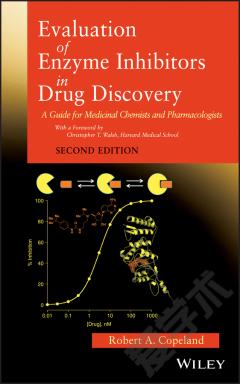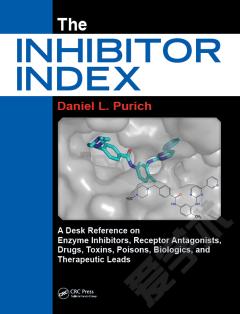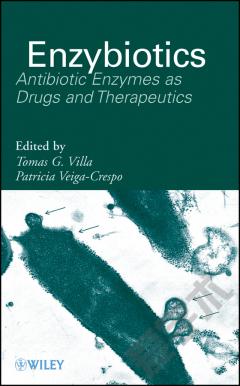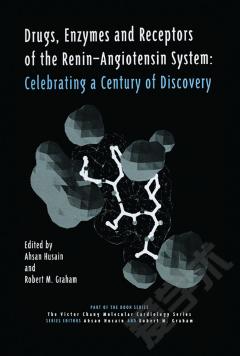Evaluation of Enzyme Inhibitors in Drug Discovery —— A Guide for Medicinal Chemists and Pharmacologists
----- 药物发现的酶抑制剂评价:药物化学家和药理学家指南 第2版
Foreword. Preface. Acknowledgments. 1. Why Enzymes as Drug Targets? 1.1 Enzymes Are Essentials for Life. 1.2 Enzyme Structure and Catalysis. 1.3 Permutations of Enzyme Structure During Catalysis. 1.4 Other Reasons for Studying Enzymes. 1.5 Summary. References. 2. Enzyme Reaction Mechanisms. 2.1 Initial Binding of Substrate. 2.2 Noncovalent Forces in Reversible Ligand Binding to Enzymes. 2.2.1 Electrostatic Forces. 2.2.2 Hydrogen Bonds. 2.2.3 Hydrophobic Forces. 2.2.4 van der Waals Forces. 2.3 Transformations of the Bond Substrate. 2.3.1 Strategies for Transition State Stabilization. 2.3.2 Enzyme Active Sites Are Most Complementary to the Transition State Structure. 2.4 Steady State Analysis of Enzyme Kinetics. 2.4.1 Factors Affecting the Steady State Kinetic Constants. 2.5 Graphical Determination of k cat and K M 2.6 Reactions Involving Multiple Substates. 2.6.1 Bisubstrate Reaction Mechanisms. 2.7 Summary. References. 3. Reversible Modes of Inhibitor Interactions with Enzymes. 3.1 Enzyme-Inhibitor Binding Equilibria. 3.2 Competitive Inhibition. 3.3 Noncompetitive Inhibition. 3.3.1 Mutual Exclusively Studies. 3.4 Uncompetitive Inhibition. 3.5 Inhibition Modality in Bisubstrate Reactions. 3.6 Value of Knowing Inhibitor Modality. 3.6.1 Quantitative Comparisons of Inhibitor Affinity. 3.6.2 Relating K i to Binding Energy. 3.6.3 Defining Target Selectivity by K i Values. 3.6.4 Potential Advantages and Disadvantages of Different Inhibition Modalities In Vivo. 3.6.5 Knowing Inhibition Modality Is Important for Structure-Based Lead Organization. 3.7 Summary. References. 4. Assay Considerations for Compound Library Screening. 4.1 Defining Inhibition Signal Robustness, and Hit Criteria. 4.2 Measuring Initial Velocity. 4.2.1 End-Point and Kinetic Readouts. 4.2.2 Effects of Enzyme Concentration. 4.3 Balanced Assay Conditions. 4.3.1 Balancing Conditions for Multisubstrate Reactions. 4.4 Order of Reagent Addition. 4.5 Use of Natural Substrates and Enzymes. 4.6 Coupled Enzyme Assays. 4.7 Hit Validation and Progression. 4.8 Summary. References. 5. Lead Optimization and Structure-Activity Relationships for Reversible Inhibitors. 5.1 Concentration-Response Plots and IC 50 Determination. 5.1.1 The Hill Coefficient. 5.1.2 Graphing and Reporting Concentration-Response Data. 5.2 Testing for Reversibility. 5.3 Determining Reversible Inhibition Modality and Dissociation Constant. 5.4 Comparing Relative Affinity. 5.4.1 Compound Selectivity. 5.5 Associating Cellular Effects with Target Enzyme Inhibition. 5.5.1 Cellular Phenotype Should Be Consistent with Genetic Knockout or Knockdown of the Target Enzyme. 5.5.2 Cellular Activity Should Require a Certain Affinity for the target Enzyme. 5.5.3 Buildup of Substrate and/or Diminution of Product for the Target Enzyme Should Be Observed in Cells. 5.5.4 Cellular Phenotype Should Be Reversed by Cell-Permeable Product or Downstream Metabolites of the Target Enzyme Activity. 5.5.5 Mutation of the Target Enzyme Should Lead to Resistance or Hypersensitivity to Inhibitors. 5.6 Summary. References. 6. Slow Binding Inhibitors. 6.1 Determining k obs : The Rate Constant for Onset of Inhibition. 6.2 Mechanisms of Slow Binding Inhibition. 6.3 Determination of Mechanism and Assessment of True Affinity. 6.3.1 Potential Clinical Advantages of Slow Off-rate Inhibitors. 6.4 Determining Inhibition Modality for Slow Binding Inhibitors. 6.5 SAR for Slow Binding Inhibitors. 6.6 Some Examples of Pharmacologically Interesting Slow Binding Inhibitors. 6.6.1 Examples of Scheme B: Inhibitors of Zinc Peptidases and Proteases. 6.6.2 Example of Scheme C: Inhibition of Dihydrofolate Reductase by Methotresate. 6.6.3 Example of Scheme C: Inhibition of Calcineurin by FKBP-Inhibitor Complexes. 6.6.4 Example of Scheme C When K i << K i : Aspartyl Protease Inhibitors. 6.6.5 Example of Scheme C When k 6 Is Very Small: Selective COX2 Inhibitors. 6.7 Summary. References. 7. Tight Binding Inhibitors. 7.1 Effects of Tight Binding Inhibition Concentration-Response Data. 7.2 The IC 50 Value Depends on K i app and [E] T . 7.3 Morrison's Quadratic Equation for Fiting Concentration-Response Data for Tight Binding Inhibitors. 7.3.1 Optimizing Conditions for K i app Determination Using Morrison's Equation. 7.3.2 Limits on K i app Determinations. 7.3.3 Use of a Cubic Equation When Both Substrate and Inhibitor Are Tight Binding. 7.4 Determining Modality for Tight Binding Enzyme Inhibitors. 7.5 Tight Binding Inhibitors Often Display Slow Binding Behavior. 7.6 Practical Approaches to Overcoming the Tight Binding Limit in Determine K i . 7.7 Enzyme-Reaction Intermediate Analogues as Example of Tight Binding Inhibitors. 7.7.1 Bisubstrate Analogues. 7.7.2 Testing for Transition State Mimicry. 7.8 Potential Clinical Advantages of Tight Binding Inhibitors. 7.9 Determination of [E] T Using Tight Binding Inhibitors. 7.10 Summary. References. 8. Irreversible Enzyme Inactivators. 8.1 Kinetic Evaluation of Irreversible Enzyme Inactivators. 8.2 Affinity Labels. 8.2.1 Quiescent Affinity Labels. 8.2.2 Potential Liabilities of Affinity Labels as Drugs. 8.3 Mechanism-Based Inactivators. 8.3.1 Distinguishing Features of Mechanism-Based Inactivation. 8.3.2 Determination of the Partition Ratio. 8.3.3 Potential Clinical Advantages of Mechanism-Based Inactivators. 8.3.4 Examples of Mechanism-Based Inactivators as Drugs. 8.4 Use of Affinity Labels as Mechanistic Tools. 8.5 Summary. References. Appendix 1. Kinetic of Biochemical Reactions. A1.1 The Law of Mass Action and Reaction Order. A1.2 First-Order Reaction Kinetics. A1.3 Second-Order Reaction Kinetics. A1.4 Pseudo-First-Order Reaction Conditions. A1.5 Approach to Equilibrium: An Example of the Kinetics of Reversible Reactions. References. Appendix 2. Derivation of the Enzyme-Ligand Binding Isotherm Equation. References. Appendix 3. Serial Dilution Schemes. Index.
{{comment.content}}








 京公网安备 11010802027623号
京公网安备 11010802027623号